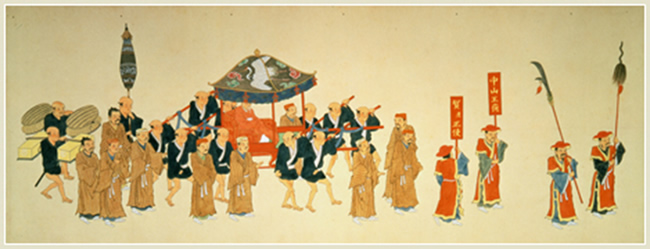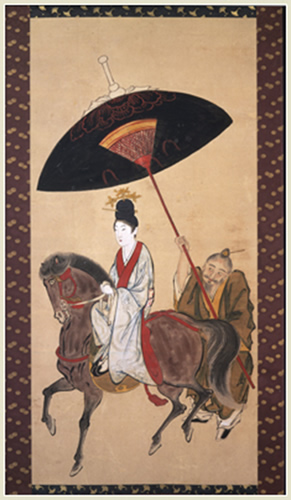1. Joint Research and Compilation Project on Pictopedias of Everyday Life
We undertake three joint research projects for the compiling on: A. Multilingual Version of Pictopedia of Everyday Life in Medieval Japan;B.Pictopedias of Everyday Life in Early Modern Japan Focusing on the Ryukyu Islands;C.Pictopedias of Everyday Life in Modern Europe.Our goal is the creation of a systematic reference method for pictorial cultural materials as “pictopedia”, an attempt unique in the world. Also, we hope to establish the Research Center for Nonwritten Cultural Materials as an international research base through the compilation of the pictopedias.
Director, Tagami Shigeru will be responsible for "Joint Research and Compilation Project on Pictopedias of Everyday Life" forms the axis o of the Joint Research Projects in the Center.
A. Joint Research and Compilation Project on Multilingual Version of Pictopedia of Everyday Life in Medieval Japan

Aim of the joint research project
Compilation and Joint Research on the Multilingual Version of Pictopedia of Everyday Life in Medieval Japan: Of the five volumes of the Pictopedia, we have published Volumes 1 and 2 through the 21st Century COE Program, and Volume 3 through the (previous) first joint research project at the center. Our goal is to translate and publish all five volumes in the next three years. We hope that researchers in history, folklore, anthropology, literature and other disciplines will then use this text in reference to various aspects of Japanese folk culture.
Task assignment for the joint research project
| Research leader | BOCCELLARI John |
|---|---|
| Joint researchers | RATCLIFF Christian |
| Research collaborators | HE Bin, KIMI Yasumichi, LI Li, NAKAI Maki, SEO Dong Chun |
B. 『Joint Research and Compilation Project on Pictopedias of Everyday Life in Early Modern Japan Focusing on Amami and Okinawa


Aim of the joint research project
For the compilation of this pictopedia, the customs and culture of the Ryukyu Islands in the Early Modern Era will be studied based on illustrated materials such as: the illustrated scroll Ryukyu Toshinkei (Scenes from the Ryukyu Islands) which depicts the customs of the people of the Amami region in this period, predating the chronicle Nanto Zatsuwa (Miscellaneous Accounts of the Ryukyu Islands); the illustrated scroll Ryukyu Shinkosen Zu Byobu(Folding Screen of Ryukyu Tribute Boat ); Kinsei Ryukyu Fuzoku Ezu (Illustrations of the Early Modern Folk Customs of the Ryukyu Islands), introducing the culture of the main island of Okinawa (Ryukyu); and the Illustrations of Yaeyama Kuramoto Painters on the Yaeyama Islands.
From 2013, we have changed as described above the name of this study group.
Because the expression "the Ryukyu Islands" is an abstract representation not a nature place name or administrative place name. For that matter, It better referred to as "Amami and Okinawa" is specifically, and its name meets the reality of pictopedias the Center tries to edit.
Task assignment for the joint research project
| Research leader | OGUMA Makoto |
|---|---|
| Joint researchers | WATANABE Miki |
| Research collaborators | MAEHIRA Fusaaki, MOTOMURA Ikue, TANA Masayuki, TOKUNO Toshimi, TOMIYAMA Kazuyuki, TOMIZAWA Tatsuzo, KAWANO Kazuaki |
C. Joint Research and Compilation Project on Pictopedias of Everyday Life in Modern Europe

Aim of the joint research project
The source material for this work will be pictorial representations of everyday scenes and activities (genre paintings), widely produced in 18th century Europe. Editing and commentary will focus on the urban culture of this period, approaching the subject through social history and comparative culture. We plan to publish the first of the two-volume pictopedia on the French-, German-, Italian- and English-speaking countries of 18th century Europe at the end of the fiscal term.
Task assignment for the joint research project
| Research leader | TORIGOE Teruaki |
|---|---|
| Joint researchers | KOMATSUBARA Yuri, KUMAGAI Kensuke, BUCHENBERGER Stefan |
| Research collaborators |
2. Joint Research on Concessions and Media Space in East Asia

“Miscommunication of Fire Disaster”(Wu You Ru Hua Bao,1983)
Aim of the joint research project
This project continues the investigation and research initiated in the first joint research project on the history of former Japanese concessions in China and Korea and their present conditions. We will also embark on a comparative study of the concessions (including leased territories and land for rail lines) and settlements in pre-war China, Japan, and Korea. In addition, through scrutiny of Japanese-language newspapers and magazines published in China and Korea in this period, we hope to reveal much about the state of the Japanese media space in the areas.
Specifically, we will carry out examinations and comparisons of photographs and pictorial images which appeared in illustrated magazines published in the Japanese concessions, such as"The Young Companion", "The pe-yang Pictrial News", "King", "North China Daily Newspaper", "Tairiku Shinpo", and "Daitowa Gaho".
Along with continued efforts to collect such visual records, we will engage in correlating the collected material and holding study meetings to which outside researchers are invited. In addition, we will hold work shops once or twice a year in locations in China, Korea or Yokohama to disseminate the results of our research both within the university and to the general public, and to publish reports on our research findings.
Task assignment for the joint research project
| Research leader | OSATO Hiroaki |
|---|---|
| Joint researchers | KIM Young Bum, MURAI Hiroshi, SON An Suk, UCHIDA Seizo |
| Research collaborators | KIKKAWA Yoshikazu, KURIHARA Jun, TOMII Masanori |
3. Joint Research on Continuity and Transformation of Scenery as Seen from Japanese Shrines Site

Aim of the joint research project
Before World War II, the Empire of Japan reportedly established as many as 2000 Shinto shrines in its concessions overseas. Most of the shrines were taken down after the war, but the remains of some can still be recognized.
In the 21st Century COE Program of Kanagawa University Joint Research Project Study (Group 3, Task 3) titled "Interpretation of the Traces of Human Activity and Natural Disasters Inscribed into the Environment," we constructed "Database of Japanese Shrines Built Abroad during the Japanese Imperial Period", which has been made public. After its transfer to the Research Center for Nonwritten Cultural Materials, the database continues to be updated and revised annually. Furthermore, the information in the database has served as the basis for the ongoing "Study Group for Japanese Shrines Built Abroad During the Japanese Imperial Period".
With the support of the members of this Study Group for Japanese Shrines, the present study will involve field work on overseas Japanese shrines from the perspective of continuity and change in scenery. The project team will reconstruct the shrines and trace the changes they underwent after the war, how certain aspects have endured and others have been transformed. By learning about the history of each shrine, it will become possible to sum up their significance as a whole.
Task assignment for the joint research project
| Research leader | TSUDA Yoshiki |
|---|---|
| Joint researchers | NAKAJIMA Michio, SENSUI Hidekazu |
| Research collaborators | INAMIYA Yasuto, KANEKO Nobuya, ZUSHI Minoru, WATANABE Natsuko |
4. Joint Research on Environmental History of Waterfront Life

Aim of the joint research project
The goal of this joint research project is an examination of the lives and cultures of the people who lived in estuarine environments from the perspective of environmental history. At the same time, we plan to establish a methodology of research on oral histories as a form of nonwritten cultural material, and environmental history of life. Specifically, we have taken up two major themes utilizing this approach:
(1) History of the Ebune (Houseboat) People
The ebune people, who lived in houseboats, emerged in the Edo period. Even in modern times, groups of people continued to live in ebune in many areas of Japan, adopting a variety of livelihoods and lifestyles. The subjects of our study will be the history of the houseboat people of Dokai Bay in Kita-Kyushu city who transported coal to the Yawata Iron and Steel Works, along with temporal changes in the environment and scenery of the Dokai Bay region. We will conduct fieldwork to collect oral histories of individuals who lived in ebune, as well as photographs and video footage.
(2) Folk Cultures of Estuarine Environments
Many estuaries, lagoons and endorheic (drainage) lakes of the Japanese islands have brackish water environments, fostering the development of unique regional folk cultures. For example, in estuarine environments, the presence of both freshwater and saltwater fish has led to the development of unusual fishing methods, and distinctive methods of lowland agriculture have also developed in such areas. Estuaries also often served as important shipping points where cargo would be transferred to and from large trading vessels to river boats. By piecing together the unique cultural attributes of the estuaries, we hope to identify the existence of an "estuarine culture" and provide new insights into the living environments of Japan
Task assignment for the joint research project
| Research leader | YASUMURO Satoshi |
|---|---|
| Joint researchers | KAWASHIMA Shuichi, MORI Takemaro, TAGAMI Shigeru |
| Research collaborators | FUJIKAWA Miyoko, MATSUDA Mutsuhiko, TSUNEMITSU Toru, WAKAMIYA Koichi, YAMAMOTO Shino |
5. Joint Research on Effective Retrieval and Secure Distribution of Nonwritten Cultural Materials

Aim of the joint research project
The goal of this joint research project is the construction of a basic technology to enable researchers and the public to share and exchange information on nonwritten cultural materials. Using the new technology, we will create a pilot system based on cultural materials and researchers to verify its effectiveness.
In order to achieve the results stated above, we will create a simplified system based on our proposed technology based on the Mingu (folk implement) card database of Tadami-cho. Our ultimate goals are as follows:
- Construct a specialized ontology for nonwritten cultural material and devise a system to enable accurate retrieval of information and discovery of new insights.
- Design a user interface suitable for construction and retrieval with respect to the ontology of nonwritten cultural materials.
- Develop a secure distribution system to ensure protection of personal data and confidential information during retrieval and dissemination, and to autonomously manage mediation of copyrights.
- Propose a method of payment based on local currencies so that writing of papers and reports, data processing, and distribution can proceed without difficulty.
- Initiate collaborations between nonwritten cultural materials and language engineering, and propose a system for generating dialogue based on nonwritten cultural materials
Task assignment for the joint research project
| Research leader | KINOSHITA Hirotsugu |
|---|---|
| Joint researchers | MATSUZAWA Kazumitsu, NOTO Masato, SANO Kenji |
| Research collaborators | KOMATSU Daisuke, SUZUKI Kazuhiro |
